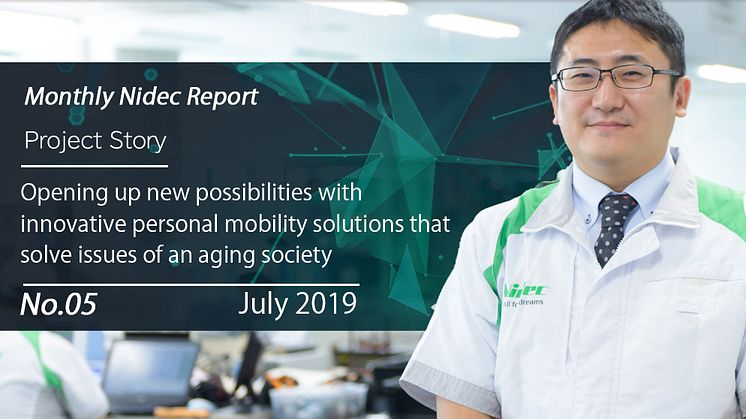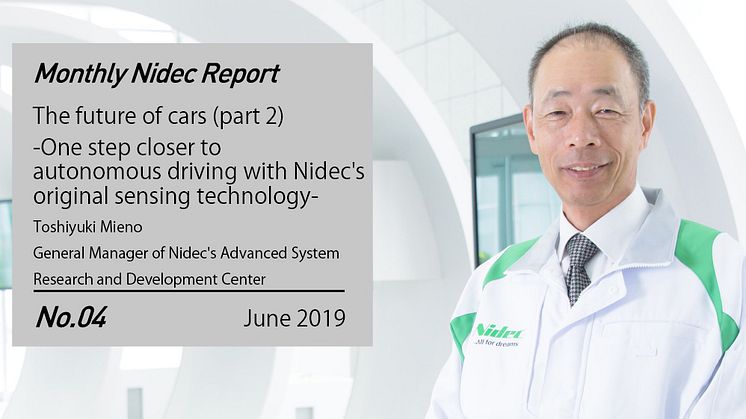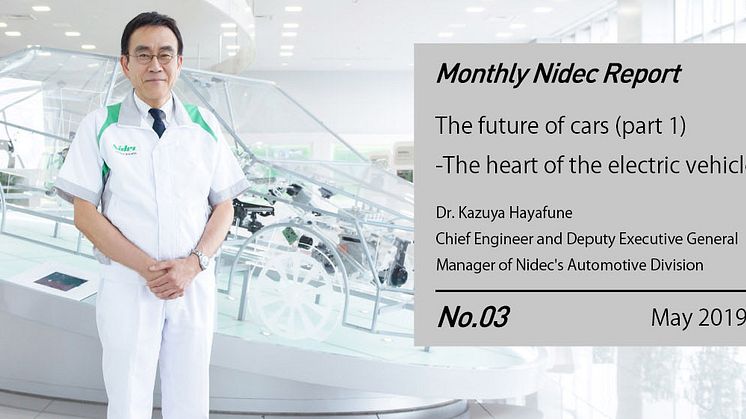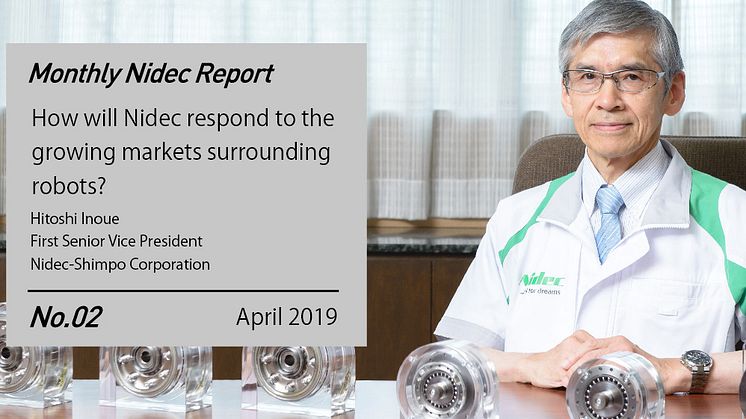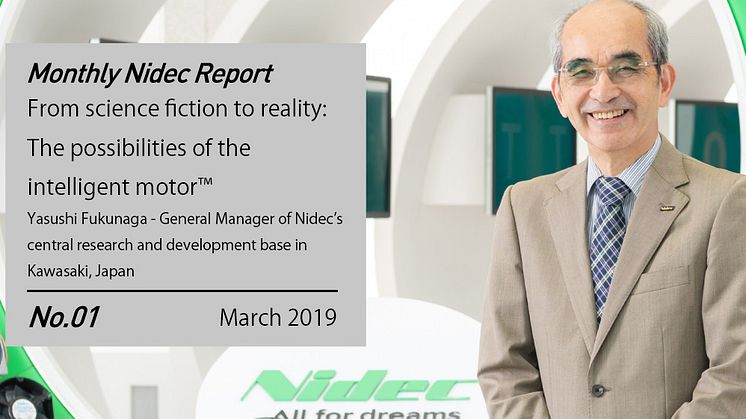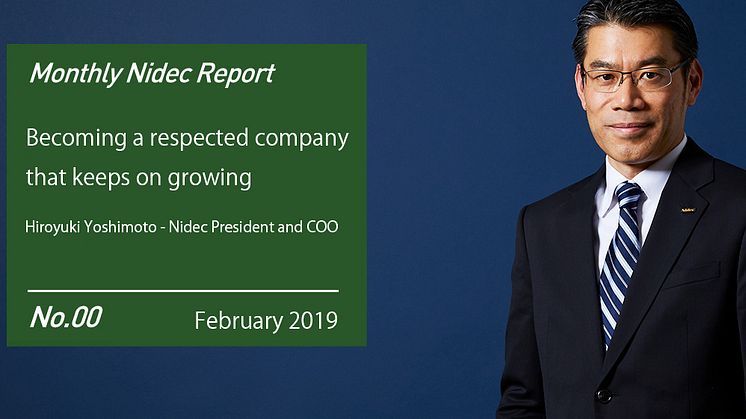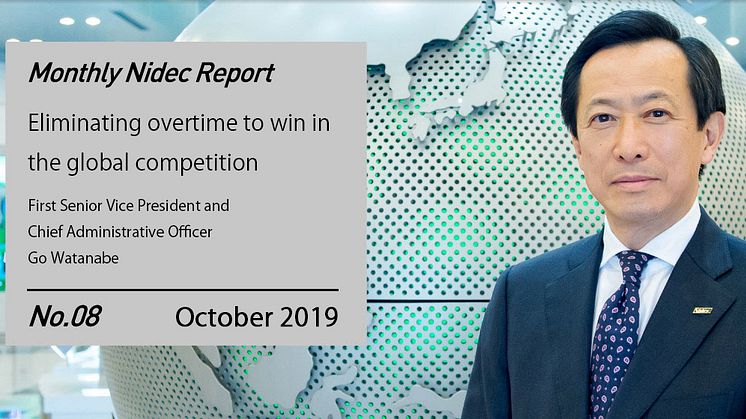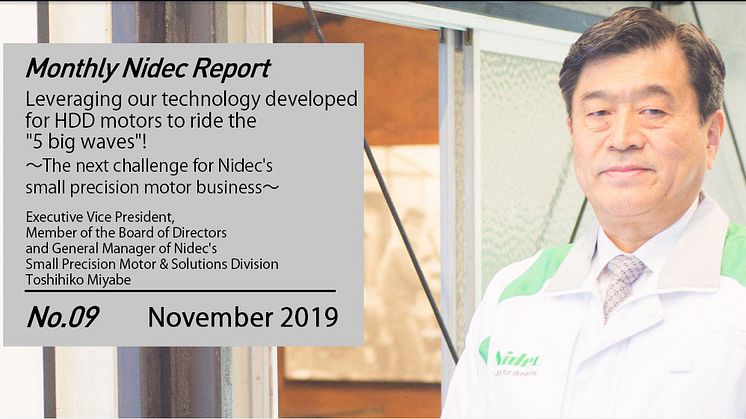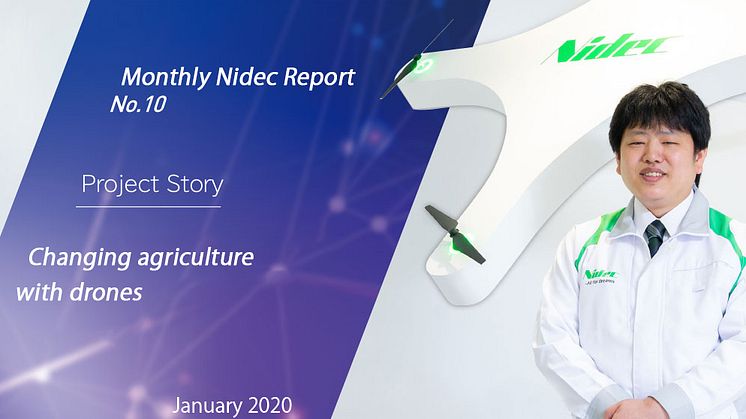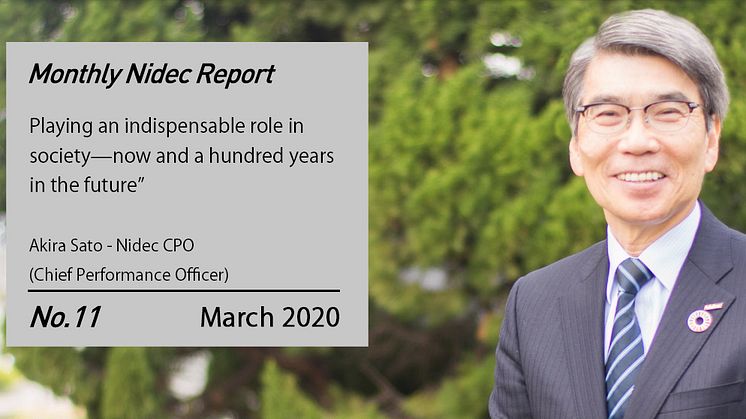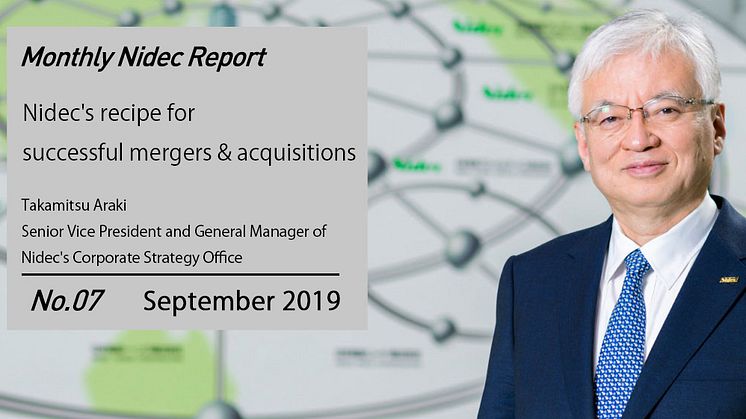
Blog post -
Monthly Nidec Report - Nidec's recipe for successful mergers & acquisitions
Nidec is known for making active use of mergers & acquisitions (M&A) as a part of its management strategy.As a pioneer in this field among Japanese companies, the company has closed more than 60 deals around the world, all of them succeeding in boosting growth. Although small to medium-sized acquisitions remained the focus for the first couple of years, Nidec has recently shifted gears and engaged in an increasing number of large-scale transactions. By leveraging its extensive experience, the company has continued to evolve its expertise in successful M&A.
A specialized team organized in 2006

- What role does Nidec's Corporate Strategy Office play in the M&A process?
The corporate strategy office mainly focuses on planning, preparing and executing the mergers, acquisitions and joint venture projects of the Nidec group. Our company has a history of acquiring struggling businesses and making them profitable again. For example, in 2003 we acquired the Japanese manufacturer Sankyo Seiki Mfg. (currently known as Nidec Sankyo). At the time, Mr. Nagamori, the founder and CEO of Nidec, personally led the turn-around project on location. These days, on the other hand, many of our acquisitions are focused on accelerating growth by branching off into new markets. Also, both the frequency and the scale of the acquisitions have increased as well.Taking these things into account, it was no longer feasible to rely entirely on Mr. Nagamori himself in all matters related to M&A. Thus, we established the corporate strategy office in 2006 in order to pivot to a more organizational approach. At the time, it was quite rare for Japanese companies to have specialized teams dedicated to mergers and acquisitions so in a sense we were pioneers.
- How many team members do you have right now?
We're a team of eight, including me. Outside of Japan some very large corporations are known to have teams of over 100 people. In these cases, everything, including the legal aspects, is usually handled in-house, which makes for some really large teams. In comparison, Nidec’s corporate strategy office may seem small, but since we work together with various outside organizations like investment banks and law firms, depending on the particulars of each deal, I wouldn’t say that we compare unfavorably in terms of workload or quality.
- Many American and European companies renowned for their M&A prowess focus not only on acquiring but also on selling businesses. How does this compare to Nidec's strategy?
Our basic philosophy is to hold on to the companies that we acquire. We have closed over 60 deals so far and our medium- to long-term goal has always been to make the companies grow, become more financially capable and finally be able to engage in M&A themselves. As the acquired companies reach this stage, one after another, the overall growth of the group accelerates as a result.
Combining "rocks" and "stones"
 The headquarters of Nidec Motor
The headquarters of Nidec Motor
(acquired from Emerson Electric in 2010)
- How do you go about deciding what companies to acquire?
Mr. Nagamori often compares M&A to the stone walls of Japanese castles. Unlike European castle walls that use mortar, the Japanese counterparts are constructed using a different method developed to withstand earthquakes. Large rocks form the bulk of the wall and smaller stones are used to fill the cracks between the rocks.
When explaining Nidec's M&A strategy in terms of castle walls, the large rocks represent acquisitions aimed at creating new business platforms. Usually this involves large-scale projects. One example would be Emerson Electric's motor business, currently known as Nidec Motor, which we acquired in 2010. Due to Nidec Motor’s global network of R&D bases, production facilities and sales offices in countries like the US, Mexico, China and the UK we were able to grow our customer base and sales capacity, especially in the US, as a result of the acquisition. The deal also strengthened the Nidec group in other ways as well due to their talented employees and excellent technological capabilities that helped strengthen our lineup of industrial motors. Just like the word “platform” suggests, this acquisition provided a basis for further growth.
The stones between the rocks in the castle walls, on the other hand, refer to the missing pieces that are necessary in order to fill the gaps in each business platform. This could be anything from expanded R&D capabilities to a stronger production network or new sales channels or after-sales services. For instance, sometimes the deciding factor is the synergy between our products and those of the companies that join the Nidec group let us upgrade our product offering from stand-alone components to integrated modules.
Other times synergy can come in the shape of geographical presence that helps us develop a stronger global footprint and gain new customers. An example from the first category would be the Taiwanese company CCI that develops and manufactures metallic cooling components for semiconductors and electronic circuits. By combining their business with our cooling fans for servers and computers, we can now supply cooling modules that bring even more added value to our customers.
An example of a geographically beneficial acquisition would be that of Genmark Automation acquired by Nidec Sankyo in 2018. Both Genmark and Nidec Sankyo manufacture robots that transport semiconductor wafers and by joining hands the two companies were able to not only strengthen their lineups but also expand their respective overseas sales networks. These so-called "stones" in the castle walls may be smaller than the “rocks” in terms of scale, but nevertheless they play very important roles in the overall growth of the Nidec group.
- How do you find potential deals?
Good matches are few and far between. If you look at it from the perspective of supply and demand the imbalance is evident. There is an overwhelming demand and far too few opportunities.
It's not uncommon for buyers to first hear about potential deals that weren’t on their radars before from investment banks, but in our case it is more common that we find the opportunities ourselves through our own active research. We keep an up-to-date list of companies that we believe would fit into, and strengthen, the Nidec group and we make sure to approach these companies regularly to gauge their interest. The list is compiled based on information from a variety of different sources analyzed by the corporate strategy office. Nidec is made up of many business units that cover different industries, and naturally the general managers of each unit are deeply involved in the process when it comes to acquiring companies in their respective fields.M&A is always on everyone's mind as a tool that can be used to achieve our goals, so the growth strategies for each business unit are envisioned with the next M&A opportunity in mind. The role of my team is to communicate with the business units to sort out priorities and find opportunities.
3 key points to success

- It is said that most mergers and acquisitions fall short of their goals. What is the secret behind Nidec's track record of successful acquisitions?
There are three key points: acquisition price, PMI * and synergy. First of all, when it comes to the price of the acquisition, a commonality found in many unsuccessful cases is the mistake of acquiring at too high of a price.This is something that must be avoided at all costs. What constitutes a reasonable price is of course a matter of definition to some degree, but it is not uncommon for the sellers to add a premium on top of the “right price.” This is especially common when companies are sold by investment funds, so we try to look for deals elsewhere. Having said that, price trends can vary quite a bit in capital markets. For example, the surging interest in electric vehicles and autonomous driving has driven up prices of companies related to these areas. In other words, many companies have become “too expensive,” and consequently Nidec has had a somewhat conservative approach to M&A in the automotive field during recent years, but speculation in this field has started to cool down and return to more “reasonable” levels so I expect that we will have more opportunities to announce deals in the automotive field will going forward.
*PMI, Post/merger-Integration, is the overall process of integrating acquired or merged businesses in order to realize synergy and increase value.
 Nidec-Shimpo is a Nidec group company that manufactures motion control and power transmission equipment like robotic speed reducers and gearboxes, press machines, measuring instruments and ceramic art equipment among other things.The company, previously known as Shimpo Industrial, was acquired by Nidec in 1995 through a third-party allocation of shares and became a wholly owned subsidiary in 2003.They have since experienced remarkable growth, especially from the 2010s and onwards. In fact, Nidec-Shimpo saw a nearly fivefold increase in sales between 2010 and 2017. Nidec-Shimpo is a Nidec group company that manufactures motion control and power transmission equipment like robotic speed reducers and gearboxes, press machines, measuring instruments and ceramic art equipment among other things.The company, previously known as Shimpo Industrial, was acquired by Nidec in 1995 through a third-party allocation of shares and became a wholly owned subsidiary in 2003.They have since experienced remarkable growth, especially from the 2010s and onwards. In fact, Nidec-Shimpo saw a nearly fivefold increase in sales between 2010 and 2017.M&A plays a central role in the growth strategy that enabled Nidec-Shimpo to grow so rapidly; the company has built up a track record of repeatedly making successful acquisitions in promising markets and thereby acquiring indispensable technologies.Examples include the press manufacturers Minster Machine Company (US) and Arisa (Spain), as well as the gearbox manufacturer MS-Graessner (Germany). These acquisitions have been instrumental in strengthening Nidec-Shimpo's product lineup. Nidec's corporate strategy office is involved in acquisitions undertaken by group companies, like Nidec-Shimpo, as well, although in a supporting role. The lead role is played by the acquiring company.Each company in the Nidec group funds their acquisitions through their own business and make acquisitions on a scale that makes sense to them.When the post-merger integration has been successfully completed, they look for the next project and the cycle continues. The acquired companies grow after joining the Nidec group, and the acquiring companies are able to grow their businesses using their own resources. There are many more examples of success stories like this in the Nidec group.  Nidec-Shimpo’s head office Nidec-Shimpo’s head office |

The three management methods shared with all acquired companies
- What are your thoughts on the post-merger integration process that many companies seem to struggle with?
I have been in the business of mergers and acquisitions for 25 years, including the time before I joined Nidec, and in my experience, PMI is the most important factor in determining the success of an acquisition.I would say that the process leading up to the acquisition only accounts for 10% of what makes the M&A successful; the remaining 90% is determined by the execution of the PMI process. The key to a successful acquisition is well-executed and speedy integration.
- Successfully integrating a company and making the values and management methods align with those of the Nidec group doesn't seem like an easy task.
By no means is it easy.International acquisitions are quite a bit more challenging than domestic ones in this regard.That being said, as the Nidec group has become more and more globalized, we have built up a strong global pool of managers with profound understanding of Nidec's core values and management methods.For example, when we acquired the motor & drive business Leroy-Somer based in France, we had key persons from our industrial motor business unit fly in from the US to meet the Leroy-Somer executives and give a breakdown of Nidec.
They explained our three key management methods*, "well digging," "household accounting" and "bite-size problem solving," and were met with nods and expressions of understanding and approval.The members of our global management team who have internalized Nidec's values and methods were able to overcome the cultural barriers and connect with the French management team.Seeing this made me realize how far-reaching Nidec's management philosophy has become.In addition to the three concepts I mentioned earlier, Nidec-style management entails other things as well: hands-on management—understanding and getting involved in the daily operations—as well as attention to details.
All of these methods and concepts are applied globally. Business performance management is generally done a week-by-week basis, although some business units keep track of, and report, figures daily.These detail-driven management methods speed up the PMI process and enable smooth improvement.
*Nidec's three management methods: "Well digging" = when digging a well, water will keep flowing after you strike water. In the same way, when facing a problem, a stream of new ideas and solutions will appear if you examine the details. "Household accounting" = just like households keep track of income/expenses and adjust their livelihoods accordingly, so too must businesses do. "Bite-size problem solving" = sometimes a problem may seem too daunting and difficult to overcome, but by taking the problem apart and dividing it into more manageable bite-size pieces the solution will often become apparent.

Nidec founder Nagamori talking about the company group's management methods in front of Leroy-Somer employees
- In addition to acquisition price and PMI, you also mentioned synergy as one of the three key points. What are your thoughts on the importance of synergy?
In general, synergy comes in two shapes: increased sales and decreased costs. An example of sales synergy is cross-selling. By acquiring a business with a different customer base, that company can sell their products to Nidec's existing customers and Nidec can offer their products to the customers of the acquired company. Additionally, as the combined business portfolio of the company group grows, we can offer new products and solutions which has a positive effect on the sales of both companies.
Cost-based synergy, on the other hand, kicks in immediately as our global procurement team can purchase necessary material in bulk. For example, let's say that there is a company that manufactures motors and procures a certain amount of raw materials. Since most motors, regardless of type, generally are made up of the same materials Nidec can procure the same material at a lower price due to bulk discounts as we manufacture over 3 billion motors every year. Oftentimes, we can acquire twice as much, or even ten times as much, of the same material for the same price.This enables us to reduce costs even more when we join hands with other companies through M&A. For the acquired company, these improved terms are usually very favorable.
- During what stage of the M&A process do you estimate the technological and synergetic value of the short-listed companies?
We do a preliminary estimation early on. Although it's never possible to make a perfect prediction, we are quite confident in our judgement as we have a lot of experience and usually our estimates turn out to be highly accurate. If the early-stage estimate is naive or overly optimistic, there is a risk that the means becomes the purpose.Moving along without a clear idea of the value of the company can be fatal as costs associated with the M&A accumulate over time, making it difficult to turn back. During the due diligence phase, in the final stages of the acquisition, you have the opportunity to pull out if you discover something that isn't right, but at this point you may have already accrued significant costs and turning back can be quite expensive.For this reason, having an early accurate estimate is of great importance.


New opportunities born out of experience
- Apart from the three points you mentioned, what other things characterize Nidec's M&A activities?
Nidec respects and values its employees as well as the employees of the acquired companies.Mass layoffs and reorganizations are commonplace in the context of mergers and acquisitions, but at Nidec we do things differently: we create growth through smooth integration.We have a proven track record of this style of M&A and potential acquirees are aware of this.They are usually quick to approach us and invite us to consider acquiring them. Selling a company is never an easy decision for an owner, especially when there is a risk that employees lose their jobs. I believe that, as humans, it is natural for the previous owners to want to see their companies flourish and grow after the deals as well.
- Is it important that there is chemistry between the acquirer and acquiree as well?
Absolutely.Cultural compatibility is an important factor and another thing we investigate during the initial phase of each acquisition. We generally don't make any sweeping changes to the management teams, just like we do not engage in mass layoffs.Motivation is another key factor when it comes to successful mergers and acquisitions, and it is important that the management can stay motivated and fulfill their potential.For this reason, we always seek to meet with the management team of the to-be-acquired company as soon as possible. Talking to each member individually is the easiest way to gain their understanding and to understand their situation. This too contributes to successful integration.
- Lastly, tell us about what role the corporate strategy office will fulfill moving forward.
Nidec has set two ambitious medium-to-long-term goals in terms of sales: 2 trillion yen in FY2020 and 10 trillion yen in FY2030.We plan to achieve these goals with an equal balance of organic and M&A-based growth.As we grow, the scale of the acquisitions we make is likely to grow as well.We are also seeing rapid growth in markets related to our business like electric vehicles, autonomous driving, IoT and robotics.There are also other opportunities that we need to catch, like the shift in demand from stand-alone motors to modules.Taking these things into account, we will have to keep a close eye on various global trends and plan acquisitions that help us adjust to these changes or act preemptively to put us in a better position.It will not be easy, but I look forward to contributing to the growth of the Nidec group by producing results at a steady pace.
 Nidec holds the thoughts of the acquired company's employees and their craftsmanship in high regard. One example that I often use is that of Nidec Sankyo.Nidec Sankyo, previously known as Sankyo Seiki Mfg., was founded in Nagano prefecture, Japan in 1946. The company joined the Nidec group in 2003 and changed its name to Nidec Sankyo in 2005. Nidec holds the thoughts of the acquired company's employees and their craftsmanship in high regard. One example that I often use is that of Nidec Sankyo.Nidec Sankyo, previously known as Sankyo Seiki Mfg., was founded in Nagano prefecture, Japan in 1946. The company joined the Nidec group in 2003 and changed its name to Nidec Sankyo in 2005.Their diverse product portfolio spans motors, motor drive units, industrial robots and sensors, but they also manufacture and sell music boxes. It may seem strange that a technology company that manufactures cutting edge components and devices also produces music boxes, but actually these music boxes were the first products that the company started mass-producing in 1950.These music boxes are the pride of the employees and are held in special regard by the local people as well.This is something that we at Nidec think should be treasured. In terms of growth and profitability, the Music Box business may not be the largest contributor, but its symbolic value to Nidec's Sankyo's employees cannot be understated.It would not be right for us to cut something like that loose.Instead, we encourage the cultivation of artisanship and strive to be the best manufacturer of music boxes in the world.We believe that Nidec Sankyo's music box business is a source of vitality and energy for the company and its employees.  |

